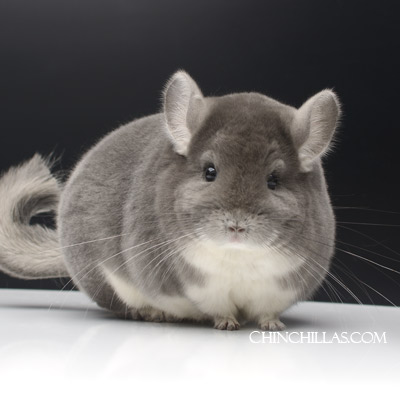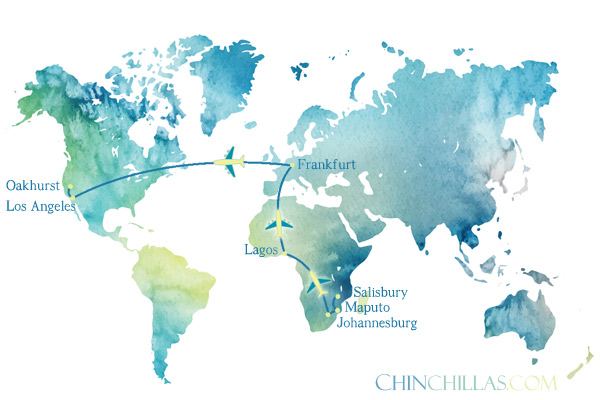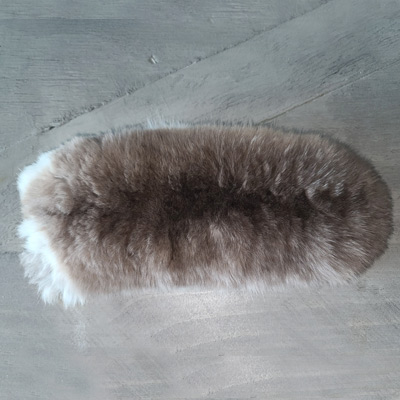Mr. X and the Violet Chinchilla

The long lost story of
The Elusive Mr. X and the Violet Chinchilla, by Loyd Sullivan
The following account is being published by Chinchillas.com, & courtesy of PSK Chinchilla. Some of the information on genetics contained in the article below is still valid, however, a few of the old hypotheses are dated and no longer considered viable today. Please note that Chinchillas.com does not advocate for chinchilla pelt production, but is publishing the following article for its educational and historic value.
Part 1 of 3
Published June 26, 2024
Webster defines a mutation as a “sudden inheritable change appearing in the offspring of a parent organism due to an alteration in a gene or chromosome, or an increase in the number of chromosomes.” The appearance of a new mutation is usually spontaneous and accidental. Mutations can also be man made so to speak: as an example: If three recessive animals with different mutant coats are mated in the proper sequence, a new color will automatically appear at the ratio of one to every sixteen births.
The primary reason for our abundance of food and fiber in the
Of all [m]ink pelts being marketed, the vast majority are mutations. The first mutation mink appeared in 1939. Incidentally these blue mink were named Silver-Blu, and were very close to the color of VIOLET. At the first auction, pelts went for over $400.00. At present, there are approximately 50 distinctly different genetic factors in mink, which affect color.
I wish to stress that over 95% of mutation mink are recessive, as are the VIOLETS.
Unfortunately, many mutations that appear are of no value, due to many things. Some never reproduce their likeness, or are sterile. Many lack vigor or are very small, and some colors are not acceptable to the Fur Trade.
This was my experience on my first venture at mutation breeding, with a herd purchased in 1963. The herd consisted of sixty standard animals and two light beige with tan underfur and pink eyes. They were very small, thinly furred, but crystal clear. As there were no records, it took 18 months just to prove that they were recessive! This was the most prolific strain that I have experienced. They reproduced their color without any variation at all. However, this was their downfall, as apparently the gene, or genes, for color was so strong that it could not be altered.
After 12 years of up-breeding, I got size and density on these critters, but could never get the veiling coverage up enough to make a decent pelt. When I acquired the VIOLET herd, I destroyed 90% of the recessive beige, a much wiser but poorer man.
Most of us are familiar with the romantic tales associated with chinchillas as recorded in history books, prior to the turn of the century. What many do not know is the intrigue involved in the sale and movement of chinchillas, once the demand heated up outside the
I had the experience of being acquainted with several promoters involved in smuggling chinchillas and cash money, to avoid custom duties and taxes. Some of these fellows had ingenious methods that would equal professional narcotic smugglers of today.
 The largest bust that I know of was made in
The largest bust that I know of was made in
When these boys were finally jailed, they sent their wives to Oakhurst to proposition the late Clement de Chant and me to falsify some sales documents in an effort to have the charges dropped, or their sentences reduced. Even though it was tempting, we both declined politely. I was told later that both received 7 years each.
One will wonder what all this has to do with the VIOLET. It’s a long story, and to protect some persons who aided me in “transporting” the Violets out of
When I toured
During my stay there, my good friend, the late Dr. D.H.W. Brown flew in from
On leaving
While in
 Shortly after returning home, I heard from my friend Mr. X in
Shortly after returning home, I heard from my friend Mr. X in
Part 2 of 3
Published July 18, 2024
Then in 1974, I received a message from Mr. X through a third party, that, due to the war, he wished to flee Rhodesia, and that he would sell me the entire herd if I would deposit the money in a bank outside Rhodesia, and keep the entire transaction top secret.
This suited me fine, as at the time the U.S.A had placed trade sanctions against
The problem now was to get the animals, from
The first of the problems was how to get the animals out of
When I began to add all of this up, I could not help but think how stupid one can be. I had just taken one beating on the recessive beige, and here I was on another wild goose chase that was costing more! Anyway, I did want to see the animals in the
So on the night of
 What worried me most was a refueling stop in
What worried me most was a refueling stop in
I notified my custom broker in
However, there was a slight hitch: they still needed to be cleared by the Dept. of Agriculture, and I noted, with dismay, that there was no health certificate with the airway bill. Although the animals all seemed pert, I told the agent that they had been in transit for six days, and would expire if not fed and watered within the hour. It was obvious that this fellow was a true animal lover, as he called me aside, and whispered in my ear “I have got to go out of the cargo area for 15 minutes. If these crates of animals are gone when I come back, I’ll swear I never knew who took them.” It only took me 5 minutes!
By
For reasons unknown to me, Mr. X would never tell me whether the animals were dominant or recessive, nor would furnish me breeding records that would indicate the genotype. However, with the number of animals we had to work with, we were reasonably sure within 6 months that we had a simple recessive: all VIOLET to Standard matings produced 100% Standard, and all Violet to Violet matings produced 100% Violet. I was pleased that the animals were recessive strain. The only drawback I can think of is that it takes some of the thrill out of checking newborn babies. With most mutation, and many standard matings, one never knows what to expect, but with the VIOLET, checking babies can monotonous, as there is very little left to chance.
Our production the first year was good from the males, but the females were slow. We blamed this on changing hemispheres, as from the second year on the females came up to average, or better, production. In 1983, our production was 2.75 per breeding female. At that time in 1975, we were almost 100% recessive beige or halfbloods, so we had to acquire standard animals of herd improvement quality to start the VIOLET program.
Their names are too numerous to mention, but I must pay tribute to the many ranchers who let me have some of their top blood lines to work into the VIOLET program. These ranchers deserve as much credit as I for the successful development of the strain.
Part 3 of 3
Published August 8, 2024
To describe the Violet, I would like to reprint an excerpt from the Mutation Breeders Bulletin of March 1982, describing twelve of the most well known mutation chinchillas:
“The last mutation to be discussed is the so called Sullivan Violet or Lavender. This herd originally was in Rhodesia and in about 1967 and in subsequent years, several of the mutant animals died when they were half grown. The rancher sent them back to Dr. Caraway, of Fort Worth, Texas, who was secretary of MCBA. They appeared to be of two different shades of violet or lavender with quite nice fur. They were encouraged to continue their mutant program, and send more casualties as they occurred. They next went to South Africa and were subsequently purchased by Lloyd Sullivan of Oakhurst, California. He has not had them in the United States for 3 to 4 years and has considerably improved their appearance. They have a beautiful white belly. They are lavender or violet in color. They have a pinkish violet appearance. They are well veiled, have a nice texture, and the underfur is the same color as the tipping, they have a thin, pale lavender bar. It is anticipated that this should be an excellent product for the fur market as it can be produced in quantity. At present, it seems to be the most promising of all the recessive mutations.”
Can the VIOLET be produced in quantity? While the first year’s progress may not seem as rapid with a recessive as with a dominant, from the second year on, production from a good recessive strain will far surpass all others. In fact, I would not be surprised to see VIOLET pelt production surpass Standards sometime in the future.
 (pictured right: Ultra Violet pelt from PSK Chinchilla, subsequent buyer of the Sullivan Violet herd)
(pictured right: Ultra Violet pelt from PSK Chinchilla, subsequent buyer of the Sullivan Violet herd)
The pelt buyers have been stressing uniformity, and I can say without reservation, that the VIOLET has the best uniformity in the industry.
Probably the most outstanding feature of the animal is the extent of the veiling coverage, which approaches perfection. They have a nice white belly, the bar is sharp and well defined. The clearness of color and density will grade #1 in the pelt. There is a slight variation in color phase, but not more than one step.
There is no lethal gene, and the strain is vigorous. We do not baby our animals; they are fed pellets and hay on a regular schedule, have clean fresh water at all times, but, I must admit, the unit and pens are somewhat neglected.
Babies are not hand fed, but we do wean out some from litters of 4 or more. Temperature in the unit ranges between 35 low in the winter to 85 high in the summer. We do use cage heaters for babies in the winter months. I am of the opinion, however, that we could increase our production with a more uniform temperature.
Of the 31 original animals, one male was chewed when received and one female chewed when pregnant the following year. These lines were culled and since then chewing has been less than 1% in the VIOLETS.
When Violets are mated to Violets, the production is 100% Violet, with no spots or monkey faces. Half blood carriers mated to Violets produce 50% Violet and 50% Standard carriers. We have actually achieved 56.6% Violets on these matings.
It is believed by many, and I concur, that the priming of fur and skin is controlled by a genetic factor. One can see animals that never are fully primed, which others in the same environment prime out evenly and completely. The Violets look smooth and prime most of the time; the big mystery is why they never have priming lines!
The Violets have crossed well with the Black, dominant Beige, and the White. On the second generation cross of Black to Violet, about 50% of the offspring are what we call the Ultra Violet. They have a darker violet color, retain the violet veiling coverage, but lose the bar and take on characteristics of the Velvet fur.
In my opinion, this animal is superior to both the Black and the Violet, but it remains to be seen if it can be produced in quantity. When mated to standards, this cross produces both standard and black. When mated to Violets, the offspring have been 100% Violet so far. All offspring of Violet to Violet whether it be TOV or regular fur produces 100% Violet color.
Another interesting color that has appeared is a pink beige, and pink white. This was accidental, and was the result of recessive beige, dominant beige and Violet crosses. The newborn[s] vary from snow white to pale beige, and at maturity, both take on a pinkish cast. When mated together, these oddballs produce young in their color range: all have pink eyes.
We have received top pelt prices from the half blood Violets, in the black, beige, and standard colors.
 In my 42 years of breeding chinchillas, I have never been as high on an animals as with the Violet. Nothing could give me the pleasure than to see all who invest in this mutation reap rich rewards. I sincerely believe this will happen.
In my 42 years of breeding chinchillas, I have never been as high on an animals as with the Violet. Nothing could give me the pleasure than to see all who invest in this mutation reap rich rewards. I sincerely believe this will happen.
I have already laid the ground work for the first pelt offering. I have taken a page of Larry Moore’s book on the promotion of his Rose mink. This mutation is sold under the trademark “Rovalia,” and tops the market year after year. This doesn’t mean that we won’t work with or through one or more of the present pelt brokers. We do intend, however, to maintain control of the product for the good of all concerned.
-THE END-
To read more, go to
The History of the Violet Chinchilla
New!
The Finding of Mr. X and the Gillingham Violet Chinchilla
Visit the Chinchillas.com Auction database to view hundreds of additional pictures of Violet chinchillas, or see new chinchillas for sale in the Sales Gallery.